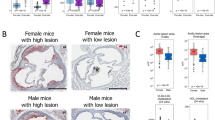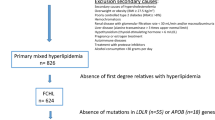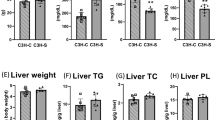Abstract
Familial combined hyperlipidemia (FCHL, MIM-144250) is a common, multifactorial and heterogeneous dyslipidemia predisposing to premature coronary artery disease1,2 and characterized by elevated plasma triglycerides, cholesterol, or both3,4. We identified a mutant mouse strain, HcB-19/Dem (HcB-19), that shares features with FCHL, including hypertriglyceridemia, hypercholesterolemia, elevated plasma apolipoprotein B and increased secretion of triglyceride-rich lipoproteins5. The hyperlipidemia results from spontaneous mutation at a locus, Hyplip1, on distal mouse chromosome 3 in a region syntenic with a 1q21–q23 FCHL locus identified in Finnish, German, Chinese and US families6,7,8. We fine-mapped Hyplip1 to roughly 160 kb, constructed a BAC contig and sequenced overlapping BACs to identify 13 candidate genes. We found substantially decreased mRNA expression for thioredoxin interacting protein (Txnip). Sequencing of the critical region revealed a Txnip nonsense mutation in HcB-19 that is absent in its normolipidemic parental strains. Txnip encodes a cytoplasmic protein that binds and inhibits thioredoxin, a major regulator of cellular redox state. The mutant mice have decreased CO2 production but increased ketone body synthesis, suggesting that altered redox status down-regulates the citric-acid cycle, sparing fatty acids for triglyceride and ketone body production. These results reveal a new pathway of potential clinical significance that contributes to plasma lipid metabolism.
This is a preview of subscription content, access via your institution
Access options
Subscribe to this journal
Receive 12 print issues and online access
$209.00 per year
only $17.42 per issue
Buy this article
- Purchase on Springer Link
- Instant access to full article PDF
Prices may be subject to local taxes which are calculated during checkout





Similar content being viewed by others
References
Genest, J.J. Jr et al. Familial lipoprotein disorders in patients with premature coronary artery disease. Circulation 85, 2025–2033 (1992).
Grundy, S.M., Chait, A. & Brunzell, J.D. Familial combined hyperlipidemia workshop. Arteriosclerosis 7, 203–207 (1987).
Goldstein, J.L., Schrott, H.G., Hazzard, W.R., Bierman, E.L. & Motulsky, A.G. Hyperlipidemia in coronary heart disease. II. Genetic analysis of lipid levels in 176 families and delineation of a new inherited disorder, combined hyperlipidemia. J. Clin. Invest. 52, 1544–1568 (1973).
Nikkila, E.A. & Aro, A. Family study of serum lipids and lipoproteins in coronary heart-disease. Lancet 1, 954–959 (1973).
Castellani, L.W. et al. Mapping a gene for combined hyperlipidaemia in a mutant mouse strain. Nature Genet. 18, 374–377 (1998).
Pajukanta, P. et al. Linkage of familial combined hyperlipidaemia to chromosome 1q21–q23. Nature Genet. 18, 369–373 (1998).
Pei, W. et al. Support for linkage of familial combined hyperlipidemia to chromosome 1q21–q23 in Chinese and German families. Clin. Genet. 57, 29–34 (2000).
Coon, H. et al. Replication of linkage of familial combined hyperlipidemia to chromosome 1q with additional heterogeneous effect of apolipoprotein A-I/C-III/A-IV locus. The NHLBI family heart study. Arterioscler. Thromb. Vasc. Biol. 20, 2275–2280 (2000).
Demant, P. & Hart, A.A. Recombinant congenic strains—a new tool for analyzing genetic traits determined by more than one gene. Immunogenetics 24, 416–422 (1986).
Groot, P.C. et al. The recombinant congenic strains for analysis of multigenic traits: genetic composition. FASEB J. 6, 2826–2835 (1992).
Pajukanta, P. et al. Fine mapping of Hyplip1 and the human homolog, a potential locus for FCHL. Mamm. Genome 12, 238–245 (2001).
Culbertson, M.R. RNA surveillance. Unforeseen consequences for gene expression, inherited genetic disorders and cancer. Trends Genet. 15, 74–80 (1999).
Leeds, P., Peltz, S.W., Jacobson, A. & Culbertson, M.R. The product of the yeast UPF1 gene is required for rapid turnover of mRNAs containing a premature translational termination codon. Genes Dev. 5, 2303–2314 (1991).
Williamson, D.H., Lund, P., & Krebs, H.A. The redox state of free nicotinamide-adenine dinucleotide in the cytoplasm and mitochondria of rat liver. Biochem. J. 103, 514–527 (1967).
Chen, K.S. & DeLuca, H.F. Isolation and characterization of a novel cDNA from HL-60 cells treated with 1,25-dihydroxyvitamin D-3. Biochim. Biophys. Acta 1219, 26–32 (1994).
Nishiyama, A. et al. Identification of thioredoxin-binding protein-2/vitamin D(3) up-regulated protein 1 as a negative regulator of thioredoxin function and expression. J. Biol. Chem. 274, 21645–21650 (1999).
Junn, E. et al. Vitamin D3 up-regulated protein 1 mediates oxidative stress via suppressing the thioredoxin function. J. Immunol. 164, 6287–6295 (2000).
Yodoi, J. & Uchiyama, T. Diseases associated with HTLV-1: virus, IL-2 receptor dysregulation and redox regulation. Immunol. Today 13, 405–411 (1992).
Gasdaska, J.R., Berggren, M. & Powis, G. Cell growth stimulation by the redox protein thioredoxin occurs by a novel helper mechanism. Cell Growth Differ. 6, 1643–1650 (1995).
Ueda, S. et al. Redox regulation of caspase-3(-like) protease activity: regulatory roles of thioredoxin and cytochrome c. J. Immunol. 161, 6689–6695 (1998).
Nakamura, H., Nakamura, K. & Yodoi, J. Redox regulation of cellular activation. Annu. Rev. Immunol. 15, 351–369 (1997).
Hirota, K. et al. AP-1 transcriptional activity is regulated by a direct association between thioredoxin and Ref-1. Proc. Natl Acad. Sci. USA 94, 3633–3638 (1997).
Holmgren, A. Thioredoxin and glutaredoxin systems. J. Biol. Chem. 264, 13963–13966 (1989).
LaNoue, K.F., Bryla, J. & Williamson, J.R. Feedback interactions in the control of citric acid cycle activity in rat heart mitochondria. J. Biol. Chem. 247, 667–679 (1972).
Kimura, R.E. & Warshaw, J.B. Control of fatty acid oxidation by intramitochondrial [NADH]/[NAD+] in developing rat small intestine. Pediatr. Res. 23, 262–265 (1988).
Sambrook, J., Fritsch, E.F. & Maniatis, T. Molecular Cloning: A Laboratory Manual 2nd ed (Cold Spring Harbor Laboratory Press, New York, 1989).
Olubadewo, J.O. & Heimberg, M. Effects of adrenergic agonists and antagonists on the metabolism of [1-14C] oleic acid by rat hepatocytes. Biochem. Pharmacol. 45, 2441–2447 (1993).
Castellani, L.W., Wilcox, H.C. & Heimberg, M. Relationships between fatty acid synthesis and lipid secretion in the isolated perfused rat liver: effects of hyperthyroidism, glucose and oleate. Biochim. Biophys. Acta 1086, 197–208 (1991).
Doolittle, M.H., Wong, H., Davis, R.C. & Schotz, M.C. Synthesis of hepatic lipase in liver and extrahepatic tissues. J. Lipid Res. 28, 1326–1334 (1987).
Lanford, R.E. & Estlack, L. A cultivation method for highly differentiated primary chimpanzee hepatocytes permissive for hepatitis C virus replication. in Methods in Molecular Medicine: Hepatitis C Protocols. (ed. Lau, J.Y.N.) 501–515 (Humana, Totowa, New Jersey, 1998).
Acknowledgements
This work was supported by grants from the National Institutes of Health and the UCLA Laubisch Fund (A.J.L.) and by a USPHS National Research award (J.B.). We thank S. Charugundla for help in the plasma lipid determinations. We appreciate the excellent technical assistance of Y. Lee, D. San Juan, L. Chen, A. Cairo, S. Tobias, K. Amburgey, D. Civello, J. Choi and Q. Zhang. We also thank O. Iakoubova, H. Sakul and R. Woychik for their expert advice. We appreciate the aid of J. Sinsheimer for the statistical analysis of recombinant animals. We are grateful to R. Davis for his comments on this manuscript. We also thank L. Peltonen, P. Pajukanta, H. Allayee and K. Krass for thoughtful discussion and input. Production of HcB-19/Dem was supported by grants from the Dutch Cancer Foundation and the European Commission (P.D.).
Author information
Authors and Affiliations
Corresponding author
Rights and permissions
About this article
Cite this article
Bodnar, J., Chatterjee, A., Castellani, L. et al. Positional cloning of the combined hyperlipidemia gene Hyplip1. Nat Genet 30, 110–116 (2002). https://doi.org/10.1038/ng811
Received:
Accepted:
Published:
Issue Date:
DOI: https://doi.org/10.1038/ng811
This article is cited by
-
Thioredoxin-Interacting Protein (TXNIP) in Cerebrovascular and Neurodegenerative Diseases: Regulation and Implication
Molecular Neurobiology (2018)
-
Disruption of TBP-2 ameliorates insulin sensitivity and secretion without affecting obesity
Nature Communications (2010)
-
NLRP3 has a sweet tooth
Nature Immunology (2010)
-
Behavioural Analysis of Congenic Mouse Strains Confirms Stress–Responsive Loci on Chromosomes 1 and 12
Behavior Genetics (2008)
-
PDGF signaling specificity is mediated through multiple immediate early genes
Nature Genetics (2007)



